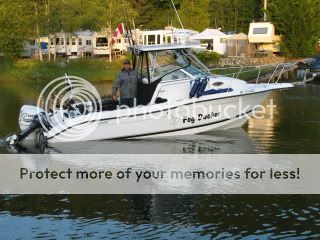quote:Originally posted by r.s craven
Wire rusts and breaks, braid does not!
i have not broken braid on a hangup yet...
either the downrigger clip gives, or the ganyon leader breaks.
Cheap wire will cause a lot more problem's in the long run.
My wire doesn't rust or break? I haven't broken a cable on a hangup in years? I must be doing something wrong, must be I don't use "cheap" cable?

quote:Originally posted by Bag-Juan
Yeah, seem,s like a bit of a riddle, I know some guy,s swear on the black box. They gotta set it to .5 for this fish & .9 for that fish! Like you say, probably helps if you're running hot. Other-wise just one more gadget to fart around with. Thanx for the come-back.
It’s not really a riddle. Your boat has an electrical charge around the hull in water. If a boat is properly bonded and properly zinced, that charge should be slightly positive when measured from ground to the downrigger cable. When the stainless steel downrigger cable is lowered into the water, the natural ionization between the cable and the boat creates a positive charge of 0.7 to 0.9 volts in saltwater and 0.3 to 0.6 volts in fresh water. This natural voltage is dependent upon salinity and mineral content of the water. In saltwater, make sure the sacrificial zincs are replaced when half dissolved. This ensures that the boat will run with a neutral or slightly positive charge. Clean zincs on a regular basis with a non-corrosive brush.
Drop backs of 10 to 20 ft. are typical. A drop back of somewhere between 50 to 100 ft. will entirely negate any effects, good or bad as the current won’t travel that far.
In short… save your money, don’t buy a black box, buy zincs!
quote:Originally posted by smiley66
The only thing that is bad though is that when you snag a ball with cable. You can get stress fractures in the cable.
This causes it to get frayed, and unwind over time.
If your drag is set correctly, there shouldn’t really be enough additional stress to create frays, but if it does fray, you should be able to see that… just cut it off and go on?
quote:Cable dragging especially in water tends to vibrate creating harmonic frequency sound in water. Does it matter? maybe... I combat it by using a good principle. Plastics/rubbers are good insulators, so I use a snubber which dampens the frequency. I have found the sound of the cable is gone.
I actually look for that sound! If you watch your cable, the pitch of that sound changes with your cable angle.
quote: Sorry I probably bored you with engineering stuff I tend to do that sometimes.
All in all I think it is a personal choice. The wire I run is the cheapest I can find. Usually Angler/gibbs. Last time I looked braided was well over 40 per 300ft. I can get three spools of wire for that.
It isn’t always a personal choice… I have Cannon, so I can’t use braid, due to the “short stop” system, but I probably wouldn’t use braid anyway?[:0]
Cheap is NOT where you want to be with your downrigger cables and I would NOT run the “cheapest” I could find? I would run the "BEST" I could find, at the "cheapest" price! All cables are not create equal! [:0][:0]
My cables are well over 5 years old and I probably fish more than the average, as I do fish year round. I watch them for kinks and frays and I rinse with fresh water and put WD40, after every use!
There is very much and a lot of difference in quality of cable. I used Scotty and Angler once… never again! I personally don’t like their cables. Neither held up and both were taken off way to soon into the season. They did nothing but fray and break! Scotty and Angler both use 304 Stainless Steel. I will only run 7 strand 316 Stainless. If it doesn’t say 316 SS on it, save your money, buy braid! I would very much prefer braid to using cheap wire!
In the end I guess it is personal choice, but it sounds from everyone on this thread, braid is a lot more trouble than my wire? I like my wire!




